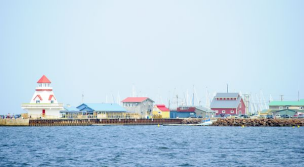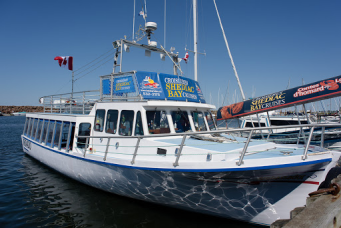Shediac, New Brunswick 作者: 来源: 发布时间:2021-12-02
I.Population and Area
-Area
Land: 53.95 km2 (20.83 sq mi)
-Population (2016)
Total: 6,664
Density: 123.5/km2 (320/sq mi)

II.Natural Geography (environment and resources)
-Shediac (2016 population: 6,664) is a Canadian town in Westmorland County, New Brunswick. The town is known as the "Lobster Capital of the World" and hosts an annual festival every July which promotes its ties to lobster fishing. At the western entrance to the town is a 90-tonne sculpture called The World's Largest Lobster.
-Shediac is situated primarily on Route 133 around Shediac Bay, a sub-basin of the Northumberland Strait.

-The town is located southwest and adjacent to the community of Pointe-du-Chêne, once the eastern terminus of the European and North American Railway as well as a stopover for Pan-Am's transatlantic "clipper" air service featuring large seaplanes. Imperial Airways' flying boat service to Foynes in Ireland also used the facilities.
III.ECONOMY
-Average in Shediac, NB: $13.31 per hour
-The average salary for a Cleaner is $13.31 per hour in Shediac, NB, which is 13% below the national average. Salary estimates are based on 11 salaries submitted anonymously to Indeed by Cleaner employees, users, and collected from past and present job advertisements on Indeed in the past 36 months. The typical tenure for a Cleaner is less than 1 year.

-Website: https://ca.indeed.com/salaries/cleaner-Salaries,-Shediac-NB
IV.Industrial Characteristics
-Agriculture and Aquaculture The food production and processing industries of New Brunswick are important components of the provincial economy, supporting the employment of 17,000 people, mostly in rural communities. Combined food and beverage shipments were valued at $2 billion in 2005.

-Website: https://www12.statcan.gc.ca/census-recensement/2016/dp-pd/prof/details/page.cfm?Lang=E&Geo1=POPC&Code1=0753&Geo2=PR&Code2=13&SearchText=Shediac&SearchType=Begins&SearchPR=01&B1=All&GeoLevel=PR&GeoCode=0753&TABID=1&type=0
V.Attractions
1.Giant Lobster

-Shediac is recognized the world over as "The Lobster Capital of the World" for its lobster fishing industry. For that reason, in 1989 the Shediac Rotary Club thought it fitting to erect a monument in tribute of the delectable crustacean and promote its role in the development of our community.
-The late Winston Bronnum from Penobquis, New Brunswick, was commissioned to create this magnificent showpiece.
-The monument stands at 11 m (35 ft.) in length, 5 m (16 ft.) in width and 5 m (16 ft.) in height. Why is it called the World's Largest Lobster? Because the sculpture weighs around 90 tonnes; the lobster alone weighs 55 tonnes while the pedestal weighs around 35 tonnes. A staircase was erected on the pedestal to allow visitors to climb up on the monument to have their pictures taken.
-Restrooms available on-site. Kayak & stand-up paddle board rental and souvenir shops nearby.
-Tel.: 506-532-7788
-Off-season: 506-532-7000
-Website: https://www.tourismnewbrunswick.ca/Products/T/The-Worlds-Largest-Lobster/
2.PARLEE BEACH PROVINCIAL PARK

-One of North America’s finest beaches, Parlee boasts the warmest salt water in Canada and has been awarded the Blue Flag international eco-certification. You’ll be amazed at the variety of activities offered at the park, including a supervised swimming beach, volleyball, ultimate frisbee, football, a sand-sculpture competition, and daily scheduled sports activities. The park’s seaside campground boasts over 210 campsites on a beautifully-groomed property. Restaurant on site.
-Nearby you'll also find shopping centres and boutiques, marinas, accommodations, cultural activities and the World’s Largest Lobster sculpture. Come spend an enjoyable day in the sun at one of the most happening beaches around!
-Please note that all park events are weather-dependent. Should you have any questions, please call the park prior to your arrival.
-TEL: 506-533-3363
-Toll-Free: 1-800-561-0123
-Website: https://www.tourismnewbrunswick.ca/Products/Parks/ParleeBeachProvincialPark/
3.Croisières Shediac Bay Cruises

-Whether you’d like to relax on the warmest waters North of the Carolinas, get a closer look at Acadian culture or discover all there is to know about lobsters, Shediac Bay Cruises has what you need!Shediac Bay Cruises was founded in 1998 by Eric LeBlanc as a way of sharing his passion for the lobster industry. Ron and Denise Cormier, who now own the business, know all about the lobster fishery: Ron is a retired lobster fisherman with 29 years of experience, and Denise’s father fished lobster for over 50 years. Along with their two daughters, Renée and Chantal, and the experienced staff of Shediac Bay Cruises, Ron and Denise are eager to show you their region and the delicacies of the sea, showing you the old fishing techniques that helped shape a way of life in their region.
By phone- (506)532-2175 and toll free 1(888)894-2002
By email- info@shediacbaycruises.ca
By fax- (506)532-2180
-Website: http://shediacbaycruises.ca/contact-us/
VI.History
-If Shediac is considered as one of the most important Acadian regions, it is , in large part, thanks to the many builders who truly believed in the area. History shows us that during the 17th and 18th century, the first Acadians to settle in the area were employed in Shediac. In 1749 most of them were hired to build a fort, houses and warehouses for the purpose of resupplying the French troops in new Acadia. Supplies coming from Québec, Louisbourg and France were unloaded from schooner ships and warehoused in Shediac to be transported later on by portage to Petitcodiac and Beauséjour from Shediac River to the Bend, from the Scoudouc River to the Memramcook River and from there to Beauséjour.
-The first Acadian settlers to permanently set up house in the area, today known as Shediac, arrived between 1798 and 1805. They settled mainly to the east of the Scoudouc River, in an area that was later known as La Batture because of the many oyster beds found at the mouth of the river.
-At the beginning of the 19th century, paths trampled on for thousands of years became the first truly organized means of public transportation in the Maritimes. New Brunswick’s first public road was constructed between Shediac and Moncton in 1816. It was on this road that the first public transit service for the east coast started up. It is therefore not surprising that the first railroad in the Maritime Provinces was established in Shediac. The first passengers were transported from Shediac to Moncton in August of 1857 on the European and North American Railway.
-Shediac was one of the most important railway centres in the country before the operations were moved to Moncton following the fire of 1872. The only remaining trace of that era is the old train station, which lasted until the 1980s when the old railway lines were removed to accommodate an office building which would eventually house the Department of Supply & Services Superannuation. Incidentally, the old railway depot was purchased by the Town in 1994 and the structure is still standing today.
-Still in the 19th century, merchandise was shipped from New Brunswick to foreign markets by sea. Because of its ideal geographic location and vast reserves of timber, Shediac was the perfect site to construct sailing ships. In 1817, the first ship built in Shediac was officially launched. This ship, built by Bowen Smith, was made of wood that was entirely carved by hand. With the emergence of new means of transportation, roads for example, as well as the development of the shipping industry in other major centres of the Maritimes, shipbuilding in this area gradually fizzled out.
-As in other Acadian communities, agriculture also played a major role in the development of Shediac. In the early 1870s, the family-owned business, Chesley Tait Company, developed an industry that was to dominate the economy of Shediac for many years. While on a trip to Bermuda, Alexander J. Tait, one of the business partners saw an opportunity to expand the business and develop the potato industry in his little seaside village. On his return to Shediac, he wasted no time in convincing local farmers to cultivate potatoes on a larger scale. During the first twenty years of the 20th century, a hundred thousand barrels of potatoes were shipped from here by rail or by sea to foreign markets in Bermuda and the West Indies, as well as to the rest of Canada.
-Shediac was also instrumental in the development of air transport. The first transatlantic airmail sent to Lancashire, England was stamped at the Shediac Post Office on June 24, 1939. Flights went from Shediac to Foynes, Eire. Prior to that, in July of 1933, the first air squadron left Italy to cross the Atlantic Ocean. Twenty-five (25) hydroplanes under the command of General Italo Balbo safely landed on the calm waters of Shediac Bay. The first commercial flights from North America to Europe departed from the Shediac terminal of Pan American Airways beginning on July 19, 1937. The «Clipper» stopped in Shediac once a week to refuel. The breakout of World War II in September of 1939 saw the decline of the hydroplanes and as a result, the Shediac terminal shut down its operations. During the war, the terminal was used by the small military planes of the Royal Canadian Air Force.
-Shediac is unique in Canada in that it was intimately linked to the early stages of all forms of public transportation: public roads, railway, passenger/cargo ships and ferries, as well as commercial aviation. Acadian settlers from the area took advantage of the development of the municipality of Shediac and today Acadians make up 75% of the population in Shediac.
-Rich in history and culture, Shediac is recognized for its avant-gardism: as the site of the first shipbuilding yard; the first steam sawmills in New Brunswick; not to mention, the first passenger railway line in the Maritimes.
-Situated near the strait of Northumberland, Shediac is famous around the world for its giant lobster, where thousands of visitors have their pictures taken each year, thus confirming our claim to fame as “THE LOBSTER CAPITAL OF THE WORLD”. The first mention of the word “lobster”, a word attributable to Captain Parkhurst, appears in the Maritimes Archives as far back as 1578.
-Closer to home, a pioneer in the lobster processing industry was named William Blizzard, a resident of Shediac. He opened a lobster processing plan in Shediac in 1861 and began to sell lobster on the open market. He was an innovator in the processing of lobster in Southeast New Brunswick. Another Shediac native whose name is synonymous with the lobster industry in the 20th century is Émile Paturel. The Paturel name was closely linked to this delectable seafood for over fifty years in Canada, the United States and Europe. The Town of Shediac certainly took advantage of this abundant natural resource and in 1949 the municipality staged the very first annual Shediac Lobster Festival, which marks it as one of the oldest festivals in the province.
VII.Other information
-Infrastructure
-The Town of Shediac will be the home of New Brunswick’s first Smart Energy Community Project as NB Power received $5.7M funding, today, to create a major new green energy initiative for the town. The project is the first of its kind in the province and will serve as a testing ground for new technologies that are being developed by NB Power and Siemens Canada.
-Today, in Shediac, Natural Resources Canada announced $10. 8M in funding for two sister projects – one to be located in the town of Shediac led by NB Power and the other located in the town of Amherst led by NS Power. The funding comes from Natural Resources Canada’s $100M Smart Grid Program.
-“Our goal is to meet the future needs of our customers in a safe, reliable, and cost-effective way by gradually eliminating the remaining 20 to 25% of our power generation that is carbon producing while ensuring we protect our customers from the significant rate increases that have resulted from this transition elsewhere,” said NB Power’s President and CEO, Gaëtan Thomas. “The only way to have a fully renewable future is with the integration of smart grid technologies that ease the acceptance of small-scale renewables onto the grid and this pilot project will allow for testing the integration of small scale solar power and battery storage along with other smart technologies into customers’ homes.”
-This new funding will help the partners deliver the entire vision for the Smart Grid Atlantic projects. The goal is to develop and demonstrate smart grid technologies that will speed the adoption of new renewable energy and storage technologies while reducing greenhouse gas emissions. The work will enable the provincial power utilities to shorten outages, better integrate customer-owned renewable energy assets onto the power grid, improve resiliency and self-sufficiency for individual communities, lower green-house gas emissions and protect customers from the potential rate increases related to the adoption of these new technologies.
-“These smart investments in electricity infrastructure build a stronger and more resilient grid and help build better connections between communities,” said the Member of Parliament for Fundy Royal, Alaina Lockhart, on behalf of Canada’s Minister of Natural Resources, the Honourable Amarjeet Sohi. “Incorporating renewables, smart meters and battery storage into Canadians’ homes and businesses will help power real change in terms of emissions reduction and increase awareness of energy consumption.”
-The utilities will also work with customers to manage energy consumption and test new electricity pricing options. Each utility will focus on slightly different aspects of testing, so that results and lessons learned can be shared across the two provinces. NS Power’s participation is contingent on approval from the Nova Scotia Utility and Review Board.
-In Shediac, 500 homes will be selected to test different technologies such as smart thermostats, solar rooftop generation, smart water heaters and in-home battery storage. The utility will also focus on potential cybersecurity issues posed by these connected devices and test varying rate schemes. In Amherst, the focus will be on commercial applications. Solar panels with battery storage on a number of commercial buildings will help manage customer demand and reliability needs, and smart electric vehicle charging will be trialed for optimal charging in the community. The construction of a solar farm in each community will add green power to the grid while giving both utilities valuable grid experience in managing solar generation of this size.
-“Our customers count on us for reliable, affordable and clean energy. As we continue to lead Canada in reducing carbon emissions, we need innovative solutions to add new energy sources to our grid,” said NS Power’s President and CEO, Karen Hutt. “Contingent on approval by our regulator, investing in the Amherst smart grid project will help us learn how to best incorporate new technologies to serve our customers, while showcasing Amherst as a progressive, smart-energy community.”
-NB Power will begin recruiting homeowners in Shediac to become part of the project – nearly a thousand are needed for Phase 1 - starting next week. NB Power will host an Open House session in Shediac, on June 18, to provide further details to the public on this pilot project and residents who are interested in potentially enrolling.
-This inter-provincial partnership supports the commitment by the Atlantic premiers and the federal government to develop a Clean Power Roadmap for Atlantic Canada.
-The projects are part of the $92.7M Smart Grid Atlantic Initiative formed by NB Power with Siemens Canada and Nova Scotia Power. This initiative received $35.7M in funding by Innovation Science and Economic Development Canada at an announcement on January 29, 2019 in Fredericton.
-The Smart Grid program is part of the Government of Canada’s Investing in Canada infrastructure plan.
VIII.Contact information
-Government
Governing body: Town Council
Mayor: Roger Caissie
-Mail:
P.O. Box 6000
Fredericton, NB
Canada E3B 5H1
Website: https://www.tourismnewbrunswick.ca/Help/ContactUs/
